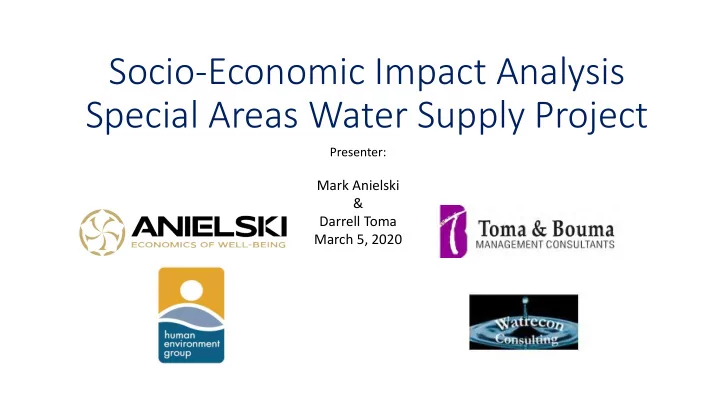

Socio-Economic Impact Analysis Special Areas Water Supply Project Presenter: Mark Anielski & Darrell Toma March 5, 2020
Consultants Profile (Edmonton) • Mark Anielski, B.A., BScF, MSc., 30 years in economics, natural capital assessments, socio-economic analysis • Darrell Toma, MSc, PAg, CMC- 40 years in economics, project analysis, agfood projects and rural economic developments • John Thompson, MA, - 40 years experience in water projects, benefit- cost, and prior author on 2005 review
AGENDA • Introductions • Goals of the SAWSP analysis • Findings
Capit pital I Investment: $372. 372.3 millio ion n (2017$) capital investment by GoA + $11 m $11 million in farm capital investment (centre pivot
SA- 80 Townships-est 23,040 ac per =1.8 million acres estimated benefit area
Irrigation Impact Area = 8,000 acres (61 quarter sections)
Multi-Use Areas Mullti-Use Areas = 4,390 acres
SA SA- Is short of a annual crop n need eeds Target= sa say 430 430mm Data ta- AB A B Agri ricu culture
Precip Gap
Precip Gap
Variability High July 2016 vrs 2014
Methods and Findings • Reviewed prior studies and did local group meeting; some interviews • Developed b-c framework and farm finance model for SA • Used Ag &F data and validated with local input • Capital cost on 8,000 acres (61 quarter sections) -is high cost project per benefiting farm • SA info- possible 270 benefiting farmers with 61 irrigation farmers • Crop mix- hay - we used 75%-farmer comments • Dugouts- have 8,600 now, we assume need 87 (1%) more- or pump • Possible benefiting- 270 farms; total 1 m acres- range and irrgtn crop
Findings: Net Benefits of Agricultural Production • Annual net benefits of agricultural production in the region resulting from SAWSP from • $4.240 million ($69,503 per quarter section) for a low scenario to • $4.446 million ($72,878 per quarter section) under a high scenario. • These values represent the difference between gross revenues received from increased crop and livestock production with irrigation, back flood forage production and stock watering, minus the increased on-farm annual costs associated with irrigation pumping and more intensive crop and livestock production.
Findings: Net Benefits of Agricultural Production Low Scenario High Scenario $2,965,926 $3,084,000 Gross Farm Benefits Total Annual Crop Benefits $246,000 $246,000 Reduced Trucking Costs $6,268,991 $8,545,001 Additional Beef Cattle-calves $2,314,066 $2,314,066 Stock water benefit;9%;water $1,037,964 $1,421,227 Risk Management Crops-reduced $12,832,948 $15,610,295 Subtotal of Benefits Deductions and $2,160,000 $3,084,000 Crop production used for added feed Adjustments for Costs $1,364,557 $1,568,797 Crop production costs $3,931,170 $5,358,863 Cattle production costs (excluding feed) $849,159 $849,159 Water supply systems costs (annual) $42,358 $57,889 Stock watering costs (annual) $8,593,244 $11,164,709 Subtotal of Costs Net Benefits After Costs $4,239,704 $4,445,586
Findings: Multi-Use Areas • The proposed 15 multi-use project areas would provide 7,037 acres of backflood irrigation, with annual estimated benefits of forage and livestock water of $61,691 per year as well as providing an estimated $98,253 per annum in economic-recreational value due to staging areas for waterfowl and habitat for upland birds, and big game.
Findings: On Farm Benefits • For farmers who decide to access water for irrigation, the potential financial benefits of investing in irrigation equipment and being able to expand cattle herds clearly exceed the costs. • Depending on the crop mix being irrigated and fed to cattle, the return on investment would be 61% under the low scenario, (payback period of 6 years), to 68% under the high scenario, (payback period of 5 years) • This rapid pay-back period is clear evidence of why farmers in the area are supportive of the project
Findings: Provincial Cost-Benefit Economics • From a provincial cost-benefit analysis perspective, the quantified discounted costs significantly exceed benefits over a 50-year period. • Even the most optimistic scenario – whereby hay, spring wheat and additional cattle (AUs) are optimally produced -- the benefit/cost ratio for the project would be no more than 0.128 (12.8 cents in benefits per dollar of cost ) with negative net present value per quarter section over the project life of -$11.6 million, using a 3.0% discount rate. • Total discounted (3.0% rate) costs (capital and annual operation) over a 50-year period would total $806.7 million compared to $102.9 million in total benefits, of which 95% would accrue to agriculture (livestock, crops) and 5% to recreation benefits.
Benefit-Cost Ratios- AB Water Projects SAWSP benefit-cost analysis reveals that the benefit/cost ratio is significantly lower than previous Alberta irrigation/water infrastructure projects (see Table): Irrigation/Water Infrastructure Project Benefit-Cost Ratio Pine Coulee Project 1.18 Oldman River dam 1.17 Little Bow Project/Highwood Diversion Plan 0.90 Milk River dam 0.80 Meridian Dam 0.33-0.35 Special Areas Water Supply Project 0.122-0.128
Findings: Socio-Economic Impacts • A socio-economic assessment shows that construction would have a small short term impact on provincial employment and income. • Construction would be completed over five years and would directly and indirectly require 2,062 person-years of employment in Alberta (265 person years of employment in the region), and account for $264 million of Alberta GDP and $153 million in labour income. • During its operational stage, water system is estimated to annually account for $5.6 million in terms of Alberta GDP and 37 person years of employment. • Regionally, the SAWSP is projected to provide 17 person-years of employment and $2.6 million in annual income.
Findings: However.. .quality of life impacts • From a macro-provincial-economic perspective the SAWSP project would be questionable, there are other local unquantified quality of life benefits to consider. • These include: • local expectations of improved economic development opportunities • opportunities for agricultural diversification and intensification • opportunities for regional value-added businesses-maybe • stabilization of regional populations- maybe • reduced demands on governments during drought events, and • reduced stress and uncertainty for farm families- yes for some.
Thank you Questions?
Multi-Use Areas
Recommend
More recommend